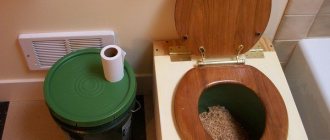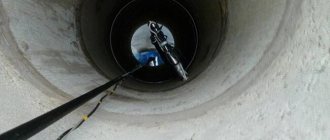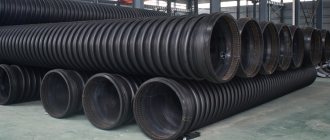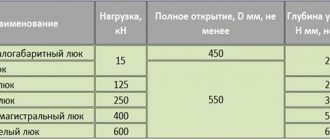The sewer system is a combination of a large number of different elements, external sewerage is part of this system. Inspection wells are used for regular performance checks and maintenance. These sewerage structures can rightly be called the central link of the entire network, since they are installed in the most difficult areas.
They facilitate access to shut-off valves and pipelines, which can run at a depth of up to 2 meters. Without a manhole, it is impossible to carry out maintenance and, if necessary, repair of the sewer system. Below we will consider what elements they consist of, their varieties, installation, etc.
Differential sewer well
It can be of five types:
- shaft bends are made up and down;
- in the form of a glass;
- with vertical water damper;
- multi-stage option;
- with corner overflow channel.
A brick sewer well includes:
- Bottom, with a single-level highway.
- Walls.
- Open tray.
- Floor slab.
- Safety hatch.
- And also wall brackets.
To carry out work and lower the operating personnel, the diameter of the device must be more than 1 meter.
Installation from concrete rings
For more information about installing sewerage from concrete rings, see this article. Initially, a pit is dug according to the conditions of excavation for the pipeline. After completing the excavation work, the bedding is laid, which is formed from coarse or medium-fraction crushed stone.
The thickness of the bedding is about 1500 mm. This element makes it possible to resist subsidence of the entire structure.
After carrying out the above measures, a layer of hydraulic insulation is installed. It can be a roll or a sheet. The formwork for the tray is applied to the insulating layer. It is possible to install a ready-made slab.
The next stage is the transition to the construction of the mine. Wells made of concrete are assembled in a zero pit, where working elements have not yet been installed.
Watch the video
The rings are laid on cement screeds. Hatches are installed in ready-made holes. After complete assembly of the structure, the pit is filled with soil.
Requirements for installation of sewer structures
The installation is carried out in strict accordance with SNiP and is regulated by GOST No. 2080 90, which states that sharp turns of the system gasket should not be allowed. It is necessary to observe the angles of the inlet and outlet pipes.
- Working elements are made of fine-grained concrete in compliance with recommended standards.
- The tank must be equipped with reinforcing rods in order to evenly distribute the load and consist of reinforcing wire.
- Before installation, you need to prepare a working diagram and carry out preparatory work, which includes clearing the site and removing vegetation, including trees.
This is not a complete list of recommendations and working conditions, which are fully reflected in the relevant documents.
Plastic sewer inspection structures
Plastic products are becoming increasingly common. They are distinguished by ease of assembly and environmentally friendly materials used in the production of structures.
Watch the video
It is important that plastic is a durable working material. The depth of a plastic sewer well can vary
Therefore, selecting the required design will not cause problems for the buyer. In addition, the cost of the complex is more attractive compared to a traditional concrete product.
Self-installation of viewing structures
Yes, this option is possible. But do-it-yourself installation is associated with certain costs and extensive preparatory work, which can hardly be completed on your own. Connecting the system to a private home may differ significantly from generally accepted principles. This may be due to the nature of the structure, groundwater levels and the structure of the work site.
The principle of work is no different from industrial installation. There are many instructional videos on the Internet. There is enough technical literature. Therefore, there is no point in dwelling on this issue in detail.
Finally
To summarize, we can note the following. There are many designs of different types and purposes. The installation issue takes into account the testimony of many services, and the optimal option is selected.
Initially, paper work will be completed: a drawing is created and the structure, which can be made of different materials, is installed according to it.
Watch the video
Note that in the private sector, ready-made options made of plastic are increasingly being used. Self-installation of structures is allowed, subject to compliance with specifications and SNiP, taking into account existing GOSTs.
Design and structure of sewer wells
As a rule, the structure of a well for sewerage has a typical structure:
- Manhole cover (upper part of the well);
- Neck;
- Camera;
- Mine;
- Bottom.
Depending on the material and which the well is made, there may be different sizes of products. The type of underground communications determines the shape of the underground chamber.
The dimensions and type of well are determined based on the requirements that are presented for the communications that will be connected to the well. As a rule, the height of the working chamber of the well is 180 centimeters.
Sewage wells
The well shaft is made in the form of a circular section. Most wells have a ladder to make it easy to get down into them. Each well must be covered with a lid. It is needed to prevent debris and dirt from falling into the well, and also to prevent someone from falling into it.
You can often hear on the news that an animal or person has fallen into an uncovered well. That is why it is strictly forbidden to use a sewer well without a cover.
Features of various types of designs
An inspection well is a round or rectangular shaft. The main compartment is an observation chamber. It has the largest dimensions; a person comes down here to carry out preventative or repair work. Metal brackets are placed on the descent wall - a ladder.
The main technical element of a manhole is a tray. It is made from concrete, pouring formwork, ready-made blocks, brick, stone. The tray part has holes for sewer pipes. Their location depends on the type of well: opposite, at an angle, at the same level or at different levels.
Variety of design types.
The working chamber is covered with a plate with a hole. A neck is installed on top, the diameter of which is smaller: the standard size is 700 mm. The hole is closed with a lid.
Traditionally they are made of cast iron, but steel ones are also available, and today plastic ones are produced. There are 3 standard sizes, which are selected depending on the neck diameter.
Polymer inspection chambers are not assembled from individual elements, like reinforced concrete ones, but are produced in a form ready for installation. Tightness and durability are ensured by materials and manufacturing technology.
Sewage inspection wells operate on a simple principle. They include a main pipeline, carefully sealed at the junction. The tray part is used for inspection. The working area is located with a slight slope for the passage of wastewater.
Location depending on destination
According to SNiP standards, there are points for mandatory installation of inspection cameras:
- in places of turns and slopes, when changing the direction of the linear pipeline;
- in places where additional branches are connected to the central line;
- in areas where pipe diameters are changed.
The entrances of private sewer networks to the central system (or collector) are also equipped with inspection cameras.
The diameter of the pipes directly depends on the length of the linear section. For example, a pipeline up to 35 m long consists of elements with a diameter of 150 mm, a hundred-meter section consists of pipes with a diameter of 700 to 900 mm, the maximum possible 300-meter line consists of pipes whose diameter can be more than 2 m.
The relationship is inverse, that is, if the diameter of the pipeline is 150 mm, then after 35 meters it is necessary to install a well.
The main location of inspection structures on a private suburban area is the line connecting storm water inlets with a settling tank, collector or filtration field
The most difficult area is selected and an inspection camera is installed. Most often this is the place where an additional sleeve is inserted, for example, coming from a bathhouse.
Manholes for private use may differ from industrial analogues in size or number of pipes, but there is no fundamental difference.
Nuances of waterproofing work
Inspection wells are dry-type technological structures, which are most often located in wet soils.
When installing these structures, waterproofing is a mandatory measure to guarantee the safety of the pipeline fittings and the effective work of cleaning or flushing the pipes.
Practice shows that leaks in prefabricated concrete structures most often occur not due to defective products, but due to improper processing of joints. This means that sealing seams is a serious and responsible procedure.
Three types of insulation are used as waterproofing compounds:
- bitumen-polymer;
- cement-polymer;
- polymer.
Bitumen-polymer waterproofing includes coating materials (mastics) and weld-on rolls, the gluing of which requires heating to a certain temperature. The second option is used less frequently, since special skills in using a gas burner are required.
One of the solutions for sealing seams using domestic waterproofing materials Penetron and Penekrit. The first is penetrating polymer-type insulation, the second is suture material, which is sold in the form of a dry mixture.
Cement-polymer compositions are cheaper, have excellent technical characteristics and are suitable for independent use. The prepared mixture is applied with a spatula in 2-3 layers to a moistened, cleaned surface, leveled and allowed to dry.
Polymer waterproofing is elastic and durable. Mastics and rolled membranes are ideal for potentially moving structures - even with a slight displacement, the sealing of the joints will be maintained.
In addition to the walls, it is also necessary to insulate the base of the well. It is usually done at the stage of laying the concrete slab, before installing the rings. The slab is covered with a cement-polymer composition, and the lower joints are also covered with it.
Video description
The video shows how to properly insert a drainage pipe into a manhole:
Part 2. Equipment of wells
A classic familiar from childhood
Everyone is familiar with the picture: a guy with a grimy face sticking out of a hatch with a shifted lid, fixing something there.
And to this day, if you ask any post-Soviet person what a sewer well is made of, in 99% of cases he will answer: “Concrete.”
And in most cases he will be right, since until now the bulk of these structures on the main pipelines of drainage systems are made in accordance with SNiP, from reinforced concrete rings, less often - cubes, or assembled from slabs.
Modern polymer systems, superior to their hard-stone predecessors in many respects, are just beginning to enter the domestic market.
However, with all its shortcomings, the traditional ring will apparently remain a symbol of the sewer well for a long time.
Such different wells
Depending on the purpose and design features, the following types of sewer wells are distinguished:
Inspection - provide access to the sewer system with a sufficiently long pipeline length. According to sanitary standards, the inspection well should be located no further than 12 m from the foundation of the building, and the distance between inspection-type sewer wells on the same pipeline should not exceed 15 m.
- Manhole body
Rotary - in their purpose they are similar to inspection manholes, but they are installed not on long straight sections, but in places where the pipeline turns. The need to install rotary wells is due to the fact that the rotation of the pipeline is a “high-risk zone” in terms of the formation of blockages, and therefore, unhindered access is required there. - Drop pipes are installed where, due to the terrain, it is impossible to lay a pipeline with the required slope.
- Storage and filter wells are designed for accumulating, settling and filtering sewage into the soil. A system of storage and filter wells is the end point in the sewer system.
Kinds
There are several types of wells that differ in their purpose and functions.
Lookout
The second name for such a well is audit, control. It is created to access communication lines that are underground. Pipes with collectors of the drainage system are replaced with conventional trays. This type of construction is optimal for places where there is a change in direction, slope or diameter, as well as at the junction on elongated and straight sections. The well allows you to check the need for sewer cleaning.
Turning
If there is an angle or turn on the highway that exceeds 45 degrees, a rotary well will be required. It is also necessary at the junctions and branches of the mesh. At the same time, such a structure can be used as an observation structure.
Perepadnoy
Used for pipeline joints whose depth may vary. Using differential structures, you can connect sewer pipes above the tray.
The well is intended for the following purposes:
- combining sewer outlets with deep-fill collectors;
- to bypass places where underground structures intersect;
- to eliminate high wastewater velocities that arise due to the high slope on the site.
Distribution
Distribution wells are used in stormwater treatment systems to control stormwater and melt flows. In addition to this structure, the system consists of a sand separator, a sorption filter, an oil and petrol separator and a well for collecting samples.
The distribution structure is a cylinder-shaped container with reinforced fiberglass, on which there is an inlet neck. The neck should be tightly closed with a lid.
There are several holes in the case:
- for receiving water;
- holes for draining liquid.
All holes are located at different levels.
The structure operates on the principle of simple surface water throughput with subsequent purification and disposal during normal operation. The well is entrusted with a task that includes the ability to carry out activities in extreme mode.
The device is able to function uninterruptedly during massive influxes of excess water from the storm drain, directing the liquid to the outlet pipe. Through it, water goes to reserve sedimentation tanks or ponds for drainage.
Overflow
Overflow wells are also called overflow septic tanks. They are several storage tanks that are connected using bypass-type pipes at the upper level. The structure is being created to collect sewage. Insoluble impurities accumulate at the bottom of the first storage tank. The purified liquid flows through inclined pipes into the next tank.
The system separates the solid and liquid phases of sewage.
Cumulative
Storage structures are a modern and environmentally friendly version of a cesspool.
The building has a significant list of advantages:
- the volume of the tank can reach 2-50 thousand liters, so you can choose a product for any purpose;
- such wells do not contribute to site pollution;
- There is no unpleasant odor near the sewer.
Users often prefer underground wells, which enhance the aesthetic qualities of the area.
How to properly install a well
There are two main technologies that are used to install sewer wells, depending primarily on the geology of the land plot.
First option
- If it is necessary to carry out installation on clay soils, then a round pit is made. In this case, the diameter should be slightly larger than the similar parameter of the ring itself, and the depth should be maximum - from 2 m.
- The rings are screwed onto the thread. In this case, additional sealant is applied at the joint.
- A substrate is placed on the bottom. It is made from stones and sand.
- A similar mixture is used to fill the space that will be between the edge of the pit and the outer surface. You can use crushed stone with a finer fraction.
Second option
- If work needs to be carried out on loose soils or those saturated with water, then the soil is initially removed to a depth corresponding to the height of the first ring of the well.
- The first ring is tried on and aligned.
- Settlement is carried out by sampling from under a ring of earth.
- The next element is screwed on in the same way.
- The process must be continued until the required depth is reached.
- With this quality of soil, it is of particular importance to install a bottom-type filter and compact the soil around the entire perimeter of the PVC ring. This will protect the device from bulging in situations where the ground freezes.
- Additionally, concrete anchors are used at the bottom of the well. This allows the rings to retain their shape after installation, even when water freezes.
There are restrictions:
- It is not recommended to use such elements in areas where there is a high seismic hazard.
- Also, the material will be useless in areas where temperatures drop below -50 degrees Celsius.
Rules for sewerage installations
no more
All plumbing fixtures must include traps with water locks, even showers and toilets. The pipe that acts as ventilation for the sewerage system must not be combined with home ventilation.
Ideally, you need to separately drain wastewater containing household chemicals from other wastewater (the chemicals have a bad effect on septic tank bacteria that are found in deep treatment stations), but in real life, a combined wastewater discharge into an anaerobic septic tank is most often used.
The septic tank should be located:
- outside the boundaries of the site;
- approximately 15 meters from the well;
- so that there is a road nearby (for the convenience of pumping out the septic tank).
- close to the soil surface.
Requirements for storm drainage:
The main purpose of this species is to collect and transport water well from the territory.
It could be:
- roofs (houses, garages, greenhouses, gazebos);
- areas with artificial turf (parking, parking, etc.);
- roads (which are located on the site).
Storm sewer is a separate element that cannot be drained into the drainage system and into domestic wastewater. Also, each rainwater inlet must have a sand filter. Inspection wells are required.
Requirements for drainage sewerage:
The purpose of drainage is to collect water from the soil and to prevent the presence of water near the foundation and blind area. For the drainage system, you need to use perforated pipes wrapped in geotextiles. The slope should be 2−3%. After purification, the water that enters the system can be used for household needs.
If you follow all the required standards and instructions, installing any type of sewerage will not be a problem. And a properly installed structure will work for many years.
Current installation requirements
When installing inspection wells, special attention is paid to the following parameters:
- In urban systems, the shaft must accommodate one adult with a set of tools.
- The main material for manufacturing hatches is cast iron for city communications and plastic for private sewers. The weight of a hatch located on the roadway is 134 kg, for sidewalks no more than 80 kg.
- The size of the neck must allow the use of cleaning devices.
Compliance with sanitary standards and installation rules allows you to avoid accidents and sewerage breakthroughs, as well as create conditions for the uninterrupted operation of monitoring equipment inside the pipeline.
Basic sanitary requirements for the construction of differential sewer wells
According to sanitary requirements, when installing a sewer system using pipes with a diameter of no more than 600 millimeters, it is not necessary to install a differential well.
When a sewer system is being constructed, the drop height of which is up to 3 meters, it is necessary to install tubular drops.
You can install a regular inspection well, which will act as a flushing well. Sometimes special structures are used that are equipped with a water supply.
In gravity flow systems, chambers and wells are recommended to be constructed according to standard designs.
It is necessary to know all the design features of the well, as well as its elements that are part of the well. The well must be marked. Don't neglect the labeling.
Common mistakes
When installing a sewer system and laying inspection wells, the following technical errors are most often made:
- The correct location for installing the first well is not observed. The recommended distance from the well to the point where the drain exits the premises should be no more than 12 meters. The optimal distance is 3-5 meters.
- Fewer wells are being installed than established by technical standards. It is recommended to install wells at a distance of 15-20 meters.
Installation
Made from concrete rings
Even before starting work, at the planning stage, the future installation location should be outlined, as well as the following activities should be carried out:
- precise marking of the area for digging a pit;
- cleaning the area;
- construction of a temporary entrance for equipment.
Next, you should level the bottom and fill it with a 20 cm layer of crushed stone. Afterwards you need to compact the filter layer, which, if necessary, will need to be sealed using bitumen mastic.
Further actions must be carried out according to the following plan:
- the base needs to be laid;
- equip the tray - form the lower part from M100 concrete, reinforce it with galvanized steel mesh;
- seal the ends of the pipes with layers of cement and bitumen;
- after 2-3 days we need to treat the inside of the concrete rings with bitumen and install them on the tray part;
- install the floor slab and neck, then seal everything;
- rub the seams with cement mortar and bitumen;
- plaster the tray;
- build a clay castle at the bottom of the well;
- check the quality of waterproofing by filling the well with water and leaving it like that for a day.
Having received successful test results, it is necessary to backfill. In the upper part you need to make a blind area and leave it open. You need to install a locking mechanism on the hatch and close everything with a polymer lid.
Made of plastic
Preparation for installation of a polyethylene chamber is carried out according to the same plan as for the installation of a concrete structure. But the work itself is carried out much faster and easier.
The entire installation process can be divided into the following steps:
- digging a pit by excavating soil to the required depth;
- arrangement of the base - filling a filter layer of crushed stone, as well as a leveling layer of sand;
- installation of a plastic well on a prepared base;
- connection of a sewer pipeline;
- backfilling with interval compaction.
There are nuances when installing a polyethylene well under a sidewalk or road. The chamber walls may simply not withstand the load and collapse, to avoid which it is necessary to install reinforced concrete slabs, which will allow the well to remain in its original position when the road surface deforms due to the displacement of the covering slabs.
For these purposes, two reinforced concrete slabs are used. A hole is made in the center of the bottom 1.5–2 cm larger than the diameter of the chamber. Then the well is lowered into the hole so that it is 9 cm above the bottom of the polyethylene product. The top slab is used as a regular floor with a hole for a hatch. The use of polymer wells in tandem with plastic pipes results in a reliable, wear-resistant system that can last for decades.
Design of water wells
Groundwater is most often collected using vertical wells (tube wells). To facilitate the work, working chambers and trays with small diameters are used.
Water intake wells of the greatest depth make it possible to create conditions for receiving groundwater that are impeccable in sanitary terms.
The flow rate (flow rate) of the tubular structure depends on the thickness of the aquifers and the filtration coefficient of the soil. The flow rate is also determined by the design features of the structure, the design of which assumes the presence of a filter and a pump. The design of any tube-type well includes the following parts:
- water intake or filter;
- operational or working;
- wellhead or head.
Pumps and a water-lifting pipeline must be provided in the working part of the wells. When designing tube wells, the following main points must be taken into account:
- number of wells;
- static and dynamic fluid level in the well;
- working chamber performance;
- placement of cameras on the site and the possibility of their mutual influence;
- conditions for transporting fluid from wells to consumers;
- designs of filters and wells, pipe diameters;
- way of designing the header;
- type of pumps used;
- reserve number of wells.
According to SNiP, the arrangement of surface water intake structures should include the ability to control the difference in liquid level on meshes and gratings.
It is necessary to ensure the ability to measure the water level in working chambers, in reservoirs or watercourses. Wells must provide the ability to measure the following indicators:
- Flow rate or volume of water supplied from wells.
- Water level in the chamber of the shaft well and collection tank.
- Pump pressure.
When the liquid level drops below the permissible level in the working part, it must be possible to automatically turn off the pumps.
Stone wells
Insulating pipes in a well with bitumen After this, the following work is performed for a concrete or reinforced concrete well:
- Preparing the base. Laying a slab or installing a concrete pad 100 mm thick from M-50 concrete
- Construction of a tray of the desired shape made of M-100 concrete with steel mesh reinforcement
- Sealing pipe ends with concrete and bitumen
- Insulation of the inner surface of concrete rings with bitumen
- Rings of sewer wells are installed (carried out after the concrete tray has gained strength, 2-3 days after installation) and a floor slab with M-50 mortar
- Grouting the joints between the prefabricated parts of the well with cement mortar
- Waterproofing joints with bitumen
- Finishing the tray with cement plaster, followed by ironing
- Installation of a clay castle at the entry points of the pipes with a width of 300 mm and a height of 600 mm larger than the outer diameter of the pipes
- Well testing (carried out within 24 hours by filling it with water to the top edge, installing temporary plugs on the pipes). Considered successful if no visible leaks are detected.
- External backfilling of well walls followed by compaction
- Construction of a 1.5 m wide concrete blind area around the well neck
- Insulation of all remaining joints with hot bitumen
The installation of brick sewer wells is carried out in a similar way, but here, instead of installing prefabricated elements, masonry is used.
Waterproofing is done in exactly the same way.
Thus, the installation of wells made of stone materials is carried out for all types of sewerage: domestic, storm or drainage.
However, in the case of a stormwater well, lattice hatches can be installed on the well, which simultaneously serve as a catchment area.
For drainage, the well itself can be a drainage element through special holes in the walls, but this design requires special calculations.
At the same time, there are slight differences in the components that the series defines: sewer wells KFK and KDK - for domestic wastewater, KLV and KLK - for storm water, KDV and KDN - for drainage.
The table of sewer wells by size is as follows:
Table of sewer wells
The process for drop wells looks a little more complicated due to their more complex configuration.
Drop well
Here, depending on the specific design, in addition to the tray design, in some cases it is necessary:
- Riser installation
- Water jet equipment
- Installation of a water barrier wall
- Creating a practice profile
- Pit device
The installation of the shaft body, base and ceiling itself is carried out according to the same rules.
The only exception concerns a drop well with a riser - a metal slab must be laid at its base to prevent the destruction of the concrete part of the structure.
It looks like this:
- Riser
- Water pillow
- Metal plate at the base of the pillow
- Receiving funnel riser
Design of a well with a riser The receiving funnel is designed to compensate for the vacuum that can be created in the riser due to the rapid movement of wastewater.
It is necessary to create differential sewer wells with your own hands using a practical profile only in exceptional cases - such a design is provided for pipelines with a diameter of 600 mm and a differential height of up to 3 m.
Similar pipe diameters are not used in individual drainage systems. But other types of wells can be successfully used in local sewerage.
In accordance with the requirements of SNiP, sewer drop-off wells are installed:
- If necessary, reduce the depth of the pipeline
- At intersections with other underground utilities
- To regulate the flow rate
- In the last flooded well before the wastewater is discharged into the reservoir
Typical cases when installing a drop well in a suburban area is advisable:
- Fast flow diagram If there is a large difference between the calculated depth of the yard sewerage system and the level of wastewater discharge into the septic tank or central collector (laying the pipeline at a shallower depth will significantly reduce the volume of excavation work)
- If there is a need to bypass other utility networks underground
- If there is any doubt as to whether the flow rate in the system corresponds to the volume of waste water. With a small volume, too high a speed can prevent self-cleaning (washing out sediment) of the pipe walls. Equally, if the speed is too low, sediment may form too intensively, then it makes sense to arrange a high-speed flow to accelerate it.
The meaning of this difference is that due to the creation of a large slope in a short section of the system, the drains begin to move much faster, without having time to cling to the inner walls of the pipe.
Which material to choose?
Manholes can be industrial or self-made. As a rule, the well design is agreed upon with the operating organization.
The industry offers various options for ready-made inspection drainage wells made of: concrete, polymers or composites. Self-made wells can additionally be made of brick or rubble. Each material has its pros and cons.
When making a drainage well with your own hands, it is necessary to take into account the frost resistance and moisture resistance of materials
The vast majority of drainage wells are made of reinforced concrete rings.
The use of concrete has its advantages:
- excellent resistance to water buoyancy;
- ability to hold heavy loads;
- possibility of manual production at the construction site;
- low price.
Reinforced concrete has a density approximately 2.5 times greater than water. It has a large mass and a high coefficient of friction with the surrounding soil, which well compensates for the buoyant force of water.
However, a large mass of concrete has its disadvantages:
- the need to use lifting equipment;
- the difficulty of making holes for the input and output of drainage pipes;
- the need to arrange access roads for the period of installation work;
- inability to achieve complete waterproofness.
Factory-ready composite and polymer manholes can be used on pipelines up to 400 mm.
The construction of a plastic manhole is reminiscent of a construction set; the shaped and functional parts fit well together. To achieve the required dimensions, the plastic is easily cut
Modern urban planning is increasingly using polymer drainage wells.
There are a number of reasons for this:
- ease of installation;
- wide selection of fittings;
- high construction speed;
- tightness;
- light weight.
Transportation of polymer or composite wells is carried out by conventional freight transport. Three people are enough to assemble and install the well.
However, such wells also have disadvantages:
- high price;
- lack of stability;
- Manufacturing according to individual design data is very expensive.
When purchasing a plastic well, you need to pay attention to the loads it can withstand, especially if the well is installed within the roadway.
Image gallery
Photo from
Installing the bottom of a plastic well
Cutting a plastic pipe into elements
Sealing for connection to the bottom
Filling soil into a trench or pit
Brick wells have pros and cons similar to concrete wells. An additional advantage of a brick well is the ease of achieving the specified dimensions. However, such a well requires more time to construct.
It is convenient to use brick to obtain the required dimensions since the necessary concrete products are not always available
Nuances of waterproofing work
Reinforced concrete inspection chambers require reliable waterproofing. External water gets inside through installation errors. The most vulnerable place is the seams between the rings and the joints of the elements.
For waterproofing the following compounds are used:
- Bitumen-polymer – mastics and roll materials. The use of the latter requires heating with a burner to the required temperature and the presence of skills.
- Cement-polymer. The surface is cleaned, moistened, and 2-3 layers of the composition are applied with a spatula.
- Polymer – roll membranes, mastics. They have an important advantage over other materials - sealing is maintained even after a slight displacement of the structure.
The base of the chamber is also insulated. It is better to do the work before installing the rings. The concrete slab is coated with the compound, and after installing the rings, the bottom seams are sealed.
Construction and operation of a septic tank made of rings
That is, in three days one person consumes approximately 600 liters of water, which means that if a family consists of three people, then a septic tank with a volume of 1800 liters will be required.
Wastewater flows through a pipe that runs from a private house into the first tank, settles, and splits into ordinary liquid and sediment, which in turn must be removed every couple of years if the treatment plant is done correctly.
The second tank is also sealed (if there are only three of them), so liquid from the first tank flows here when it reaches the level of the overflow pipe.
In the second tank, the decomposition process occurs; for this, a ventilation hole is built into it, through which methane evaporates, the remaining part precipitates in the form of sludge.
From the third reservoir, the purified liquid enters the ground if the treatment facility made of concrete rings is equipped with a drainage bottom, or is pumped out if it is an ordinary well.
Septic tank location
It is also necessary to carefully consider the location of the septic tank.
The following recommendations should be considered:
- the septic tank should be located at a distance of 5-20 m from the house;
- it is necessary to be able to drive up to the septic tank with a pumping machine or special equipment during its installation;
- you should figure out what the level of groundwater is in the selected area, check seasonal fluctuations;
- if there is a well with clean water on the site, then there should be at least 30 m from the well to the septic tank.
In order for the concrete rings to fit tightly together, you should buy them with locks.
Installation of a septic tank made of concrete rings
Let's consider the process of installing a septic tank made of concrete rings.
- First, you need to dig a pit using an excavator, but take into account the fact that when digging a septic tank, its size must be calculated in such a way that people can work freely between the pit wall and the concrete rings during the installation process.
- Sand should be poured into a layer of about 20 cm at the bottom of the septic tank.
- If rings without a bottom were purchased, then you need to concrete the place in the pit where they will be located.
- Next, using a crane, the concrete rings are installed, and the top is covered with a lid.
- Be sure to waterproof the joints between the concrete rings and between the lower ring and the concrete base. If concrete rings with a bottom are installed, waterproofing is carried out only between the joints.
- Then the pipes are laid. The septic tank is also waterproofed between the pipe and the wall of the tank.
- The septic tank is waterproofed along the outside of the installation, then the pit is filled up.
In this case, they roll it without the help of special equipment to the selected area and dig up the ground underneath it so that in the future it will lower itself into the dug pit.
What types of septic tanks are there?
Today there is a wide variety of septic tanks, but a septic tank made of concrete rings has the advantage of affordable cost. There are several types of septic tanks made of concrete rings on the market:
1) single-chamber septic tank made of concrete rings. They install only one camera 5 meters from a country house. In the future, such a septic tank will require regular pumping of liquid, so it is necessary to provide convenient access for the car to the installation;
2) two-chamber septic tank for a bathhouse. Such a septic tank consists of several tanks, since wastewater that has undergone effective treatment can be used for irrigation;
3) overflow septic tank. Its distinctive feature is that each container is installed at a level lower than the previous one. This type of septic tank is the most effective and will last for many years.
You should take into account the fact that the work of a single-chamber septic tank is not of sufficient quality and durability, so it is better to install at least a two-chamber septic tank made of concrete rings, from which the liquid can be used for economic purposes (for example, watering a garden).
Drainage systems for a private home: how wastewater is treated
Further on this page you can see practical examples of how wastewater is treated. The drainage system of the house can be arranged according to one of the proposed principles. When choosing a drainage system for a private home, it is worth considering its throughput.
Several cleaning system options are available:
1. Purflo septic tank + drainage - the system is designed for 2-10 people. The principle of operation is preliminary cleaning in a septic tank using bioculture and final cleaning through a soil filter. Recommended for use in sandy soils.
2. Purflo septic tank + biofilter - the system is designed for 2-12 people. The principle of operation of the septic tank is the same as in system 1, but post-treatment occurs in a container filled with a special filter element. It is used for clay and loamy soils, as well as for high groundwater levels.
3. Minflo - the system is designed for 7-20 people. Operating principle: preliminary cleaning in a Purflo septic tank; post-treatment occurs in the aeration tank.
It is possible to make a two-channel local sewage system: one outlet discharges feces from the toilet, and the other discharges wastewater from a shower, sink, bidet, etc. In this case, the discharge from the toilet goes into the cesspool, and the wastewater discharges into the filter trench, etc. The cesspool is made of concrete rings, the bottom is waterproofed, concreted, a blind area and a tight lid are made. The cesspool is located in a place convenient for access by a sewage disposal truck, which periodically removes emissions. If for some reason it is impossible to place a pit in such a place, a second cesspool is made near the fence, and feces are transferred from the first to the second using a fecal pump.
The pump can withstand contact with aggressive alkaline media (the chemical resistance of the device allows it to be used for pumping highly chlorinated water from swimming pools).
The manufacturer recommends choosing a more efficient model for the pool, for example, Vort 350.
Another fecal pump Wilo TMW30-02 EM (Germany) has a capacity of up to 72 l/min, a pressure of up to 30 meters, a power supply of 220 V, and a power of 700 W. Dimensions 23 x 16.5 x 16.5 cm, weight 4.3 kg.
More powerful (and less commonly used in individual areas) are Ebaro DW/DW VOX fecal pumps (Italy) with a capacity of up to 700 l/min, a pressure of up to 18 m. Of course, this increases the power consumption of such pumps - up to 1.5 kW. The capabilities of the pumps are such that they allow pumping out water even with very large and solid suspensions (up to 5 cm in diameter).
DW and DW VOX pumps are made of stamped stainless steel and have a double seal with lubricant (silicon carbide and carbon ceramic), due to which the rubbing parts of the pump are almost not subject to wear and always remain sealed. Therefore, the service life of such pumps operating in fairly aggressive environments with large suspended solids is extremely extended.
The following video shows a sewer system in a private house in a step-by-step manner with comments from experts:











